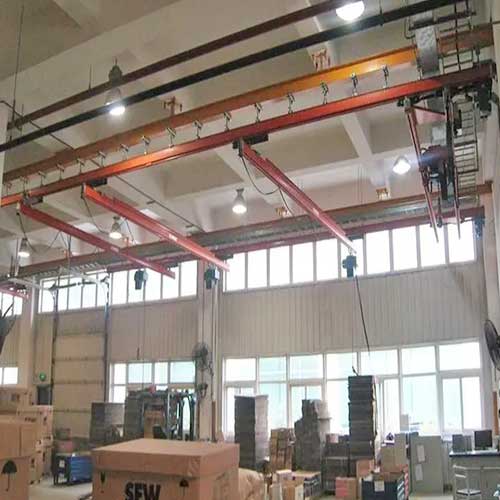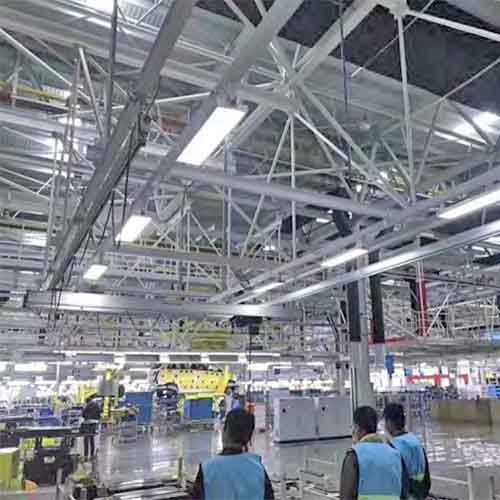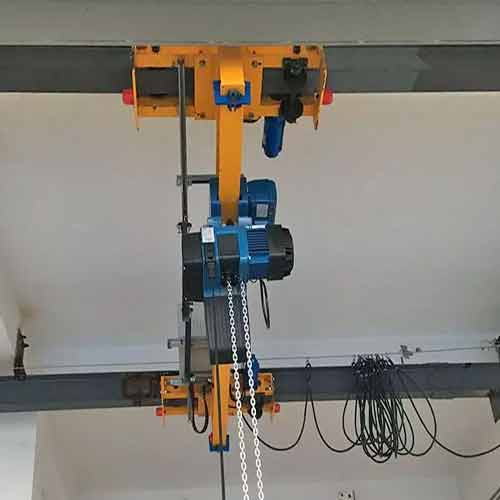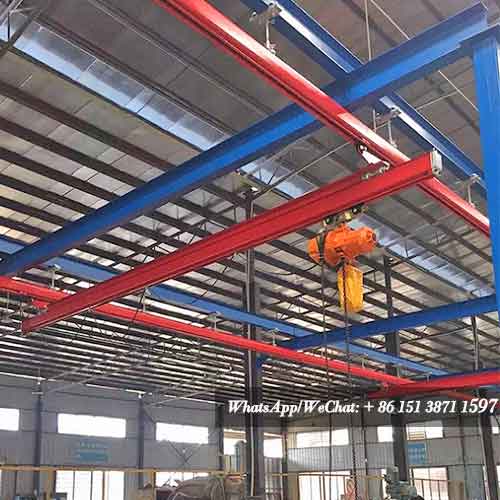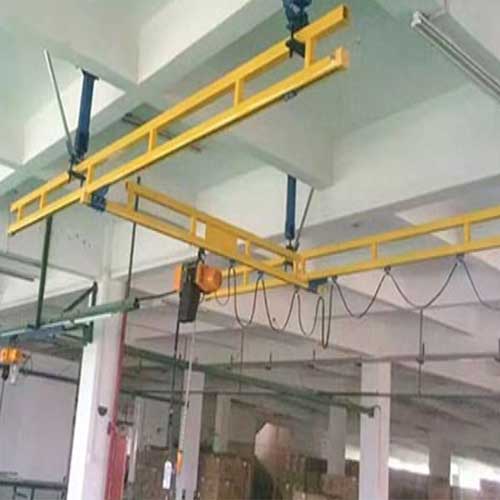Your Trusted Overhead Ceiling Crane Manufacturer & Supplier
Ceiling Crane, Ceiling Mounted Crane & Ceiling Crane System
Ceiling crane for sale 500kg -10 ton. All types of ceiling mounted crane designs, ceiling mounted bridge crane, workstation crane,monorail cranes for you.
A ceiling crane is a general term that encompasses any type of crane system that is mounted or attached to the ceiling or overhead structure of a building or workspace. These cranes are used for material handling and lifting tasks and offer various configurations and capabilities to suit different applications.
A ceiling-mounted crane specifically refers to a crane system that is attached to the ceiling or overhead structure without the need for support columns on the floor. It operates on a track or rail system mounted on the ceiling, allowing the hoist and trolley to move along a specified path. This type of crane is commonly used in industrial settings, manufacturing facilities, and warehouses where floor space needs to be kept clear for other operations.
Ceiling-Mounted Bridge Crane:
This type of crane consists of a bridge or horizontal beam that spans the width of the working area, supported by end trucks that run along tracks attached to the ceiling. Bridge cranes are available in both single and double girder configurations, offering different load capacities and spans.

Features:
- High load capacity and long spans available in double girder configuration.
- Smooth and precise movement along the bridge.
- Can cover a large area, providing flexibility in material handling.
Advantages:
- Efficient use of floor space as no support columns are required.
- Suitable for heavy-duty lifting applications.
- Ideal for moving loads across a wide workspace.
Limitations:
- May require significant initial investment for installation.
- Limited mobility within the fixed path of the bridge.
Applications:
Ceiling-mounted bridge cranes, especially those with double girder configurations, are capable of handling heavy loads and can cover large work areas. They are commonly used in heavy manufacturing, construction, and other industries that require substantial lifting capacities.
Main typs of ceiling mounted overhead crane system
A ceiling crane system refers to the complete setup of a ceiling-mounted crane, including the supporting structure, track or rail system, hoist, trolley, and any additional components required for safe and efficient material handling. The following are the main types of ceiling mounted crane systems are presented for your reference. If you have any need, please feel free to contact us to get your ceiling mounted cranes
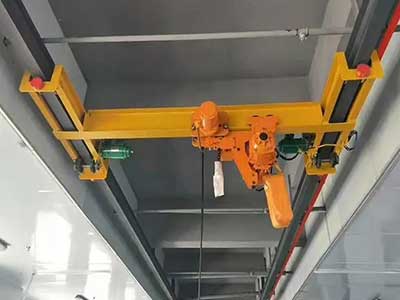
Single Girder Ceiling Mounted Bridge Crane:
- This type of ceiling-mounted bridge crane features a single horizontal beam (girder) that spans the width of the workspace.
- It is designed for lighter to moderate lifting tasks and is often used in manufacturing, workshops, and warehouses.
- Single girder cranes are cost-effective and versatile solutions for various material handling needs.
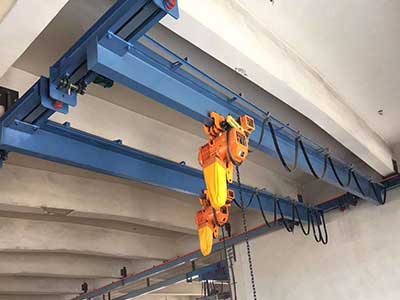
Double Girder Ceiling Mounted Bridge Cranes:
- Double girder ceiling-mounted bridge cranes have two horizontal beams (girders) that provide increased load capacity and stability.
- They are suitable for handling heavier loads and are commonly found in heavy manufacturing, steel mills, and other industrial settings requiring high lifting capacity.
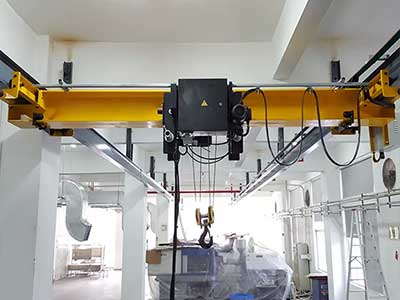
European Style Ceiling Mounted Bridge Cranes:
- European style ceiling-mounted bridge cranes are known for their advanced design, precision, and reliability.
- They often feature modular components and advanced safety features, complying with European crane standards and regulations.
- These cranes are used in a wide range of industries and are recognized for their high-quality engineering.
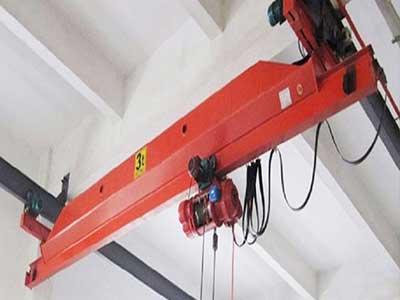
Chinese Style Ceiling Mounted Bridge Cranes:
- Chinese style ceiling-mounted bridge cranes are typically manufactured in China and designed to meet various industrial needs.
- They can vary in design and quality, and their features may differ based on the manufacturer.
- These cranes are often cost-effective options for industries looking for budget-friendly material handling solutions.
The choice between single and double girder cranes depends on the lifting capacity required for a specific application. European style and Chinese style ceiling-mounted bridge cranes may differ in terms of design, engineering standards, and quality, so it's essential to consider factors such as load capacity, safety requirements, and budget when selecting the appropriate crane type for a particular project. Consulting with crane experts or suppliers can help determine the best fit for your specific needs.
Ceiling-Mounted Monorail Crane:
Monorail cranes use a single track or rail mounted on the ceiling to support the hoist and trolley assembly. They are best suited for linear material movement along a fixed path and are commonly used in assembly lines and other repetitive production processes.
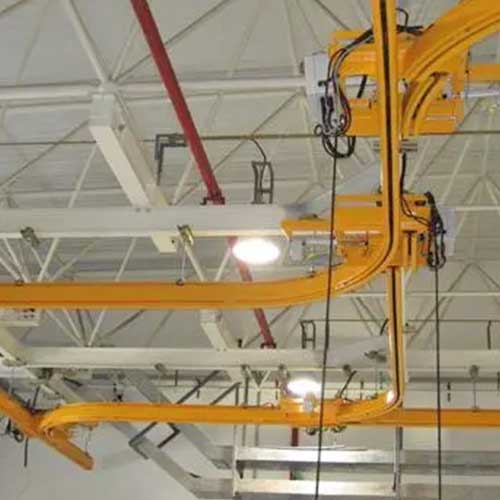
Ceiling-Mounted Monorail Crane:
Features:
- Single track allows for linear movement along a fixed path.
- Can be installed in various configurations, including single or multiple tracks.
Advantages:
- Maximizes floor space utilization.
- Ideal for repetitive material movement in a straight line.
- Can be integrated into existing production processes.
Limitations:
- Limited coverage area compared to bridge cranes.
- Not suitable for moving loads over larger distances.
Applications :
For applications that involve repetitive linear material movement along a fixed path, such as assembly lines or paint booths, monorail cranes are a practical choice. They offer smooth and efficient material transport along a single track, reducing the need for manual handling and increasing productivity.
Straight Monorail Ceiling Mounted Crane and Curved Monorail Ceiling Mounted Crane are specific types of ceiling-mounted cranes that are characterized by the shape of the monorail track they use for material handling. Here's a brief explanation of each:
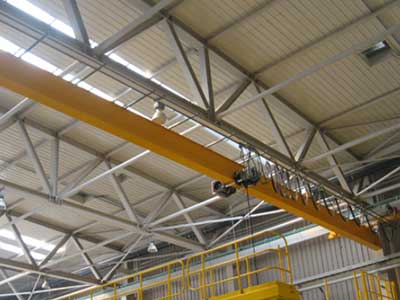
Straight Monorail Ceiling Mounted Crane:
- A Straight Monorail Ceiling Mounted Crane utilizes a straight, linear monorail track that is attached to the ceiling structure.
- This type of crane is designed for linear material handling tasks, where loads need to move in a straight line within a specific work area.
- Straight monorail cranes are commonly used for applications such as assembly lines, production processes, and moving materials from one point to another in a straight path.

Curved Monorail Ceiling Mounted Crane:
- A Curved Monorail Ceiling Mounted Crane is equipped with a monorail track that has curved sections.
- These cranes are designed for applications where loads need to be moved along a curved or circular path within a workspace.
- Curved monorail cranes are particularly useful for material handling tasks that involve maneuvering loads around obstacles or following specific production line layouts.
The choice between a straight monorail crane and a curved monorail crane depends on the specific layout and material handling needs of the workspace. Straight monorail cranes are suitable for linear tasks, while curved monorail cranes provide the flexibility to navigate around obstacles or follow curved production processes. Both types of cranes are commonly used in manufacturing and assembly applications to improve efficiency and streamline material handling operations.
Ceiling-mounted workstation crane
A ceiling-mounted workstation crane, often referred to as a workstation bridge crane or monorail crane, is a type of material handling equipment designed to facilitate the movement of loads within a specific work area or workstation. Unlike larger overhead cranes that span a wide area, workstation cranes are intended for localized lifting and transport tasks. They are typically mounted on the ceiling or overhead structure of a building and consist of a single bridge or monorail track.
Here are some key features and characteristics of ceiling-mounted workstation cranes:
- 1. Single Bridge or Monorail: Workstation cranes typically have a single horizontal bridge or monorail track that runs parallel to the work area. This track allows for the movement of the hoist and load along a fixed path.
- 2. Precise Positioning: These cranes are designed for precision and control, making them ideal for tasks that require accurate load placement.
- 3. Light to Moderate Capacity: Workstation cranes are suitable for lifting and moving loads ranging from a few hundred pounds to a few tons, depending on the specific model and configuration.
- 4. Variety of Hoist Options: They can be equipped with various types of hoists, including manual, electric, or pneumatic hoists, depending on the lifting requirements and operator preferences.
- 5. Easy Installation: Workstation cranes are often easier to install than larger overhead cranes, making them a cost-effective solution for localized material handling needs.
- 6. Modular Design: Many workstation crane systems have a modular design, allowing for easy expansion or reconfiguration to adapt to changing workflow requirements.
- 7. Enhanced Ergonomics: These cranes are designed to improve worker ergonomics and reduce the risk of injuries associated with manual lifting and handling.
Workstation cranes are commonly used in manufacturing, assembly lines, maintenance and repair areas, and other workstations where precise and efficient load movement is required within a limited space. They are an excellent solution for enhancing productivity and workplace safety in these environments.
Rigid workstation ceiling mounted crane and Flexible workstation ceiling mounted crane. These terms describe the flexibility and adaptability of these cranes for different material handling needs. Let's explore these, as well as other types of ceiling-mounted workstation cranes:

Rigid Workstation Ceiling Mounted Crane:
- A Rigid Workstation Ceiling Mounted Crane is designed for fixed or repetitive material handling tasks within a defined workspace.
- It offers precise load positioning and stability, making it suitable for applications where loads need to be moved with accuracy and minimal sway.
- These cranes are often used in manufacturing, assembly lines, and other environments with predictable material handling requirements.

Flexible Workstation Ceiling Mounted Crane:
- A Flexible Workstation Ceiling Mounted Crane is designed to provide versatility and adaptability in material handling.
- It allows for easy repositioning of the hoist and load within the workspace, making it suitable for applications with changing or varied handling needs.
- Flexible workstation cranes are commonly used in maintenance areas, job shops, and facilities with evolving production setups.
Light Duty Workstation Ceiling Mounted Crane and Heavy Duty Workstation Ceiling Mounted Crane are two distinct types of ceiling-mounted workstation cranes designed to handle varying load capacities and material handling requirements. Here's an overview of each type:

Light Duty Workstation Ceiling Mounted Crane( single girder ) :
- Light-duty workstation ceiling mounted cranes are designed for handling smaller loads and are suitable for applications where precision and flexibility are key.
- They are commonly used in settings where materials are moved frequently, but the loads are relatively light.
- Light-duty cranes are ideal for tasks such as assembly work, machine loading, and moving lightweight materials within a workspace.
- They offer easy maneuverability, precise load positioning, and reduced operator fatigue.
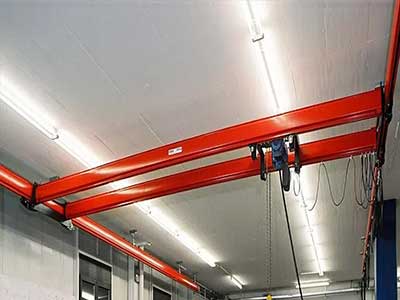
Heavy Duty Workstation Ceiling Mounted Crane ( double girder ) :
- Heavy-duty workstation ceiling mounted cranes are engineered to handle larger and heavier loads, making them suitable for industrial applications with demanding material handling requirements.
- They are commonly used in environments where loads can range from moderate to very heavy.
- Heavy-duty cranes are often employed in manufacturing facilities, warehouses, and workshops for tasks like moving heavy machinery components, loading/unloading materials, and handling bulk items.
- These cranes provide the strength and stability needed to safely lift and transport heavy objects within a workspace.
The choice between a light-duty and heavy-duty workstation ceiling-mounted crane depends on the specific load capacities and material handling needs of the workspace. Selecting the appropriate crane type ensures efficient and safe material handling operations, reduces the risk of accidents, and maximizes productivity in the given environment.
All in all, , the choice of ceiling-mounted crane system depends on the specific lifting requirements, available space, and budget considerations of the application. Each type of ceiling-mounted crane offers unique features, advantages, and limitations, making them suitable for different material handling scenarios.
Applications of ceiling mounted cranes
Ceiling-mounted cranes are a practical choice in various industrial and commercial settings when specific material handling requirements or workspace considerations need to be addressed. Here are some situations when it is beneficial to use a ceiling-mounted crane:
- Floor Space Optimization: Ceiling-mounted cranes are ideal when you need to maximize floor space for other operations, such as manufacturing, assembly lines, storage, or pedestrian traffic. Since these cranes do not require support columns on the floor, they free up valuable space below, providing more flexibility in the layout and organization of the workspace.
- Limited Floor Accessibility: In environments where the floor is congested, uneven, or not suitable for supporting traditional floor-mounted cranes, a ceiling-mounted crane can be an efficient solution. It allows you to move loads along a designated path without being obstructed by obstacles on the floor.
- Ergonomic Lifting: Ceiling-mounted cranes equipped with hoists and trolleys can be designed to meet ergonomic standards, reducing the physical strain on workers and improving safety during material handling tasks.
- Customizable Solutions: Ceiling-mounted crane systems offer various configurations and accessories, allowing you to tailor the crane to your specific lifting needs and workspace constraints. This customization ensures the crane is optimally suited for the intended application.
- Accessibility and Versatility: Ceiling-mounted cranes can be positioned strategically to reach multiple workstations, production lines, or storage areas. This accessibility enhances the crane's versatility and makes it a valuable asset in a dynamic or ever-changing work environment.
It's essential to assess the specific lifting requirements, space constraints, and safety considerations of your workplace when deciding whether to use a ceiling-mounted crane. Consulting with a professional engineer or crane expert can help you choose the most suitable crane system for your needs and ensure compliance with relevant safety regulations and standards.
Ceiling Structure designs & Ceiling mounted Crane Selections
The design of ceiling structures in industrial workshops and facilities can vary significantly based on factors such as the building's purpose, size, layout, and load-bearing capacity. The choice of ceiling structure can impact the selection and design of ceiling-mounted cranes. Below are some common types of ceiling structures and their special features, along with considerations for selecting ceiling-mounted cranes based on these structures:
Steel I-Beams or Structural Steel Frame:
- Special Features: Steel I-beams are robust and offer high load-bearing capacity. Structural steel frames provide a stable and secure support structure.
- Ceiling-Mounted Crane Selection: These structures are ideal for supporting both single and double girder overhead cranes, as they can handle heavy loads and provide ample strength for crane installation.
Concrete Beams or Precast Concrete Structure:
- Special Features: Concrete beams are durable and can withstand heavy loads. Precast concrete structures offer quick installation and a smooth surface for crane movement.
- Ceiling-Mounted Crane Selection: Overhead cranes, whether single or double girder, can be installed on concrete beams. The strength and stability of concrete make it suitable for various crane capacities.
Wooden Trusses or Joists:
- Special Features: Wooden trusses are commonly found in smaller workshops or older facilities. They are lightweight and cost-effective.
- Ceiling-Mounted Crane Selection: When dealing with wooden trusses, it's important to assess their load-bearing capacity. Lighter-duty overhead cranes or monorail cranes may be suitable, but reinforcement or structural modifications may be necessary in some cases.
Pre-Engineered Metal Building (PEMB) Systems:
- Special Features: PEMB systems are designed for rapid construction and typically have steel frames. They offer clear spans without internal columns.
- Ceiling-Mounted Crane Selection: Overhead cranes, including single and double girder options, are often used in PEMB structures due to their clear span design and structural support capabilities.
Lightweight Roof Structures:
- Special Features: Some facilities have lightweight roof structures, which may not be suitable for heavy overhead loads.
- Ceiling-Mounted Crane Selection: In such cases, lightweight cranes, such as workstation bridge cranes, may be preferred. These cranes have lower weight and load-bearing requirements and are designed for use in structures with limited strength.
High Bay Warehouses or Distribution Centers:
- Special Features: High bay structures are characterized by tall ceilings and may have specialized racking systems.
- Ceiling-Mounted Crane Selection: Overhead cranes with high lifting heights are commonly used in high bay warehouses. The crane's lifting capacity should match the requirements of the storage and retrieval systems.
Renovated or Historic Buildings:
- Special Features: Renovated or historic buildings may have unique architectural features and limited space for structural modifications.
- Ceiling-Mounted Crane Selection: Lightweight ceiling-mounted cranes, jib cranes, or wall-mounted jib cranes may be chosen to work within the constraints of the building's existing structure.
The selection of ceiling-mounted cranes is closely tied to the structural design and load-bearing capacity of the ceiling. Engineers and crane specialists assess the building's structure, including the ceiling, columns, and beams, to determine the type, capacity, and installation method of the crane. Structural modifications, if needed, are considered to ensure the safety and effectiveness of the crane system. It's crucial to work with experienced professionals who can assess the specific needs of the facility and recommend the appropriate crane and structural modifications, if necessary, to accommodate the chosen crane syst
Installation of ceiling mounted crane systems
The installation of a ceiling-mounted crane system requires careful planning and adherence to safety guidelines. Here are the general steps involved in installing an overhead ceiling crane:
- 1. Engineering and Design: Before the installation process begins, an engineering team will assess the workspace, lifting requirements, and the structural capacity of the ceiling. They will design the crane system to meet the specific needs of the application, ensuring that it complies with safety standards and regulations.
- 2. Structural Evaluation: The ceiling structure must be evaluated to determine its load-bearing capacity and suitability for supporting the crane system. A structural engineer may need to assess the ceiling's strength and integrity to ensure it can withstand the weight and forces exerted by the crane during operation.
- 3. Reinforcement, if Necessary: In some cases, the existing ceiling structure may require reinforcement to handle the additional loads imposed by the crane. This could involve adding steel beams, brackets, or other support elements to strengthen the ceiling and create secure mounting points.
- 4. Installation of Runway Beams: The runway beams, which provide the track for the crane to move along, are installed on the ceiling structure. These beams must be properly aligned and securely fastened to ensure smooth and safe movement of the crane.
- 5. Mounting End Trucks and Components: The end trucks, which house the wheels and drive mechanism of the crane, are attached to the runway beams. The hoist, trolley, and other crane components are then mounted onto the end trucks, providing the lifting and movement capabilities.
- 6. Electrical Connections: Electrical wiring and controls for the crane system are installed, allowing the operator to control the crane's movements, lifting, and other functions.
- Testing and Inspection: After the installation is complete, the crane system undergoes rigorous testing and inspection to ensure it operates safely and efficiently. Load tests are conducted to verify that the crane can handle the specified loads without issues.
Requirements for Ceiling Structure:
The suitability of the ceiling structure for mounting a crane system depends on its load-bearing capacity and overall strength. Some considerations include:
- 1. Structural Integrity: The ceiling structure must be capable of supporting the weight of the crane, hoist, trolley, and the maximum rated load of the system without compromising its integrity.
- 2. Load-Bearing Capacity: The ceiling should have sufficient load-bearing capacity to accommodate both static and dynamic loads imposed by the crane during operation.
- 3. Material and Construction: The material and construction of the ceiling structure should be appropriate for attaching the necessary brackets, beams, and other mounting components securely.
- 4. Clearance Height: Sufficient vertical clearance should be available to allow the crane system to operate without interference from obstacles or obstructions.
- 5. Professional Evaluation: It is crucial to involve a qualified structural engineer or crane manufacturer in assessing the ceiling structure and ensuring it meets the requirements for mounting a ceiling-mounted crane system.
By following these steps and ensuring the ceiling structure meets the necessary criteria, a safe and efficient ceiling-mounted crane system can be installed to meet the specific material handling needs of the workplace.
Runway structures of ceiling crane systems
The runway structure of a ceiling-mounted crane refers to the supporting framework that holds the crane's track or runway beams. This structure is attached to the ceiling or overhead structure of the building and provides a stable and secure path for the crane to move along. The runway structure is a critical component of the crane system, as it ensures smooth and safe movement of the crane and the loads being lifted.
Features of Ceiling-Mounted Crane Runway Structure:
- 1. Runway Beams: The primary feature of the runway structure is the runway beams themselves. These beams are typically made of steel and come in various shapes and sizes, depending on the crane's load capacity and the specific requirements of the application.
- 2. End Trucks: The runway structure includes end trucks or end carriages, which are fitted at both ends of the runway beams. The end trucks house the wheels and drive mechanisms that allow the crane to move along the runway.
- 3. Connection Points: The runway structure must be securely connected to the ceiling or overhead structure of the building. Proper fastening and reinforcement are essential to ensure the structure can support the weight and forces exerted by the crane during operation.
- 4. Support Brackets: In some cases, additional support brackets may be used to reinforce the connection between the runway structure and the ceiling. These brackets distribute the loads and stresses to ensure the ceiling can bear the crane's weight.
- 5. Alignment and Leveling: Proper alignment and leveling of the runway structure are crucial to ensure the crane can move smoothly and safely along the runway. Precise alignment helps prevent excessive wear on the wheels and reduces the risk of accidents.
- 6. Safety Features: The runway structure may incorporate safety features such as anti-derailment devices or bumpers to prevent the crane from accidentally running off the track.
What to Note:
- 1. Load-Bearing Capacity: The runway structure must be designed and constructed to handle the maximum rated load of the crane, including the weight of the crane itself, the hoist, trolley, and the heaviest loads that will be lifted.
- 2. Compatibility with Crane System: The runway structure should be compatible with the specific type and design of the ceiling-mounted crane being used. Different types of ceiling-mounted cranes may require different runway configurations and support systems.
- 3. Structural Evaluation: A qualified structural engineer should evaluate the building's ceiling and overhead structure to determine its load-bearing capacity and suitability for supporting the runway structure and crane system.
- 4. Compliance with Standards: The installation and design of the runway structure should comply with relevant safety standards and regulations to ensure the crane system operates safely and efficiently.
- 5. Regular Inspection and Maintenance: The runway structure, like any other crane components, requires regular inspection and maintenance to identify and address any signs of wear, damage, or structural issues.
- 6. Professional Installation: The installation of the runway structure should be carried out by experienced professionals who are knowledgeable about the specific requirements and safety considerations of ceiling-mounted crane systems.
Properly designed, installed, and maintained runway structures are essential for the safe and efficient operation of ceiling-mounted crane systems. Following the appropriate guidelines and working with qualified experts will help ensure the runway structure meets all necessary safety standards and supports the crane's performance effectively.
